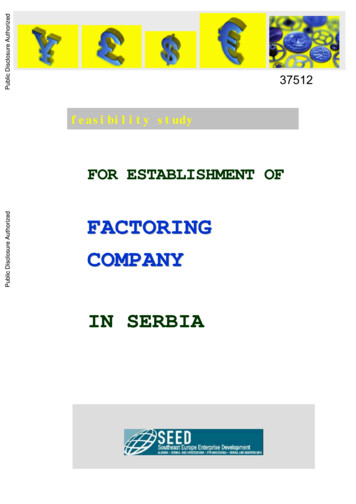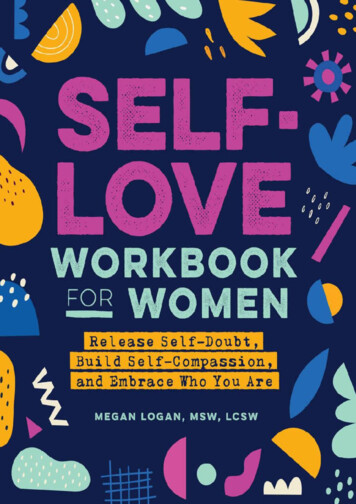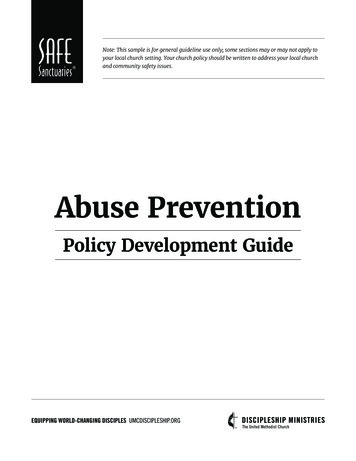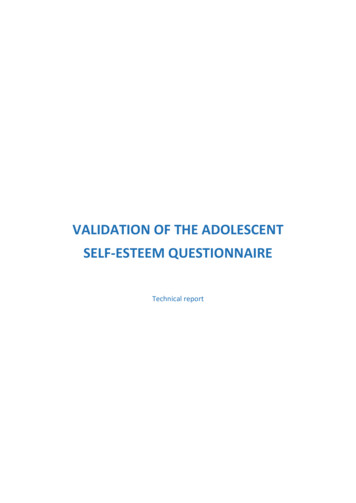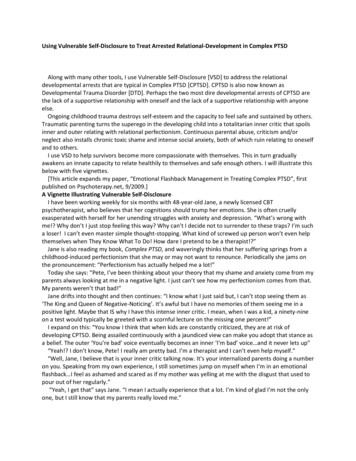
Transcription
Using Vulnerable Self-Disclosure to Treat Arrested Relational-Development in Complex PTSDAlong with many other tools, I use Vulnerable Self-Disclosure [VSD] to address the relationaldevelopmental arrests that are typical in Complex PTSD [CPTSD]. CPTSD is also now known asDevelopmental Trauma Disorder [DTD]. Perhaps the two most dire developmental arrests of CPTSD arethe lack of a supportive relationship with oneself and the lack of a supportive relationship with anyoneelse.Ongoing childhood trauma destroys self-esteem and the capacity to feel safe and sustained by others.Traumatic parenting turns the superego in the developing child into a totalitarian inner critic that spoilsinner and outer relating with relational perfectionism. Continuous parental abuse, criticism and/orneglect also installs chronic toxic shame and intense social anxiety, both of which ruin relating to oneselfand to others.I use VSD to help survivors become more compassionate with themselves. This in turn graduallyawakens an innate capacity to relate healthily to themselves and safe enough others. I will illustrate thisbelow with five vignettes.[This article expands my paper, “Emotional Flashback Management in Treating Complex PTSD”, firstpublished on Psychoterapy.net, 9/2009.]A Vignette Illustrating Vulnerable Self-DisclosureI have been working weekly for six months with 48-year-old Jane, a newly licensed CBTpsychotherapist, who believes that her cognitions should trump her emotions. She is often cruellyexasperated with herself for her unending struggles with anxiety and depression. “What’s wrong withme!? Why don’t I just stop feeling this way? Why can’t I decide not to surrender to these traps? I’m sucha loser! I can’t even master simple thought-stopping. What kind of screwed up person won’t even helpthemselves when They Know What To Do! How dare I pretend to be a therapist!?”Jane is also reading my book, Complex PTSD, and waveringly thinks that her suffering springs from achildhood-induced perfectionism that she may or may not want to renounce. Periodically she jams onthe pronouncement: “Perfectionism has actually helped me a lot!”Today she says: “Pete, I’ve been thinking about your theory that my shame and anxiety come from myparents always looking at me in a negative light. I just can’t see how my perfectionism comes from that.My parents weren’t that bad!”Jane drifts into thought and then continues: “I know what I just said but, I can’t stop seeing them as‘The King and Queen of Negative-Noticing’. It’s awful but I have no memories of them seeing me in apositive light. Maybe that IS why I have this intense inner critic. I mean, when I was a kid, a ninety-nineon a test would typically be greeted with a scornful lecture on the missing one percent!”I expand on this: “You know I think that when kids are constantly criticized, they are at risk ofdeveloping CPTSD. Being assailed continuously with a jaundiced view can make you adopt that stance asa belief. The outer ‘You’re bad’ voice eventually becomes an inner ‘I’m bad’ voice and it never lets up”“Yeah!? I don’t know, Pete! I really am pretty bad. I’m a therapist and I can’t even help myself.”“Well, Jane, I believe that is your inner critic talking now. It’s your internalized parents doing a numberon you. Speaking from my own experience, I still sometimes jump on myself when I’m in an emotionalflashback I feel as ashamed and scared as if my mother was yelling at me with the disgust that used topour out of her regularly.”“Yeah, I get that” says Jane. “I mean I actually experience that a lot. I’m kind of glad I’m not the onlyone, but I still know that my parents really loved me.”
I pause and change tack: “Yes, I bet that they thought they were being loving doing it for your owngood. And, I apologize for all the psychoeducating I guess I’m a bit stuck on some studies that showthat kids who get a higher ratio of positive-to-negative attention develop better self-esteem.”A moment of silence, and then Jane says: “Well, OK, I actually do get that! Them ALWAYS being sohard on me does look like how I’m ALWAYS so hard on myself. Even though it freaks me out to hearmyself say it: ‘I pretty much hate myself all the time!’”A short silence and she becomes teary and then angry, and says: “I wish you could have heard mymother on the phone last night. She was so awful! Beyond nasty! Really! Part of me secretly calls her‘The Queen of Dishing-It-Out’! God! What a disloyal little brat I am! But, OH! she went on and on abouthow ungrateful I am.”Jane becomes silent for a moment ,and then bursts out imitating her mother’s litany of slurs. Hermother’s toxic laundry list then seamlessly shifts into Jane resuming her own self-mocking.Feeling sad for her, I interrupt her and gently point out that she is scorning herself with the exactsame phrases and disgusted emotional tone that she just quoted from her mother. Her eyes moisten.I shift focus and wonder out loud: “Can you feel call up some sympathy for that scared little girl whocould never protest all that unfair and dead wrong criticism that little girl who spent so much time inthe abyss of anxious shame and depression that your mother and father created ?”She cuts me off: “Dammit! I can’t do anything right! You’ve given me this permission over and over,and I just refuse to be kind to myself! How can you even bear to be in the same room with me? I know Imake people sick. How’d you get so good at hiding your disgust!?”I feel a tremor of fear about her anger, but much more a tsunami of compassion for the horriblyscapegoated child that she obviously was. It’s so sad that little children can be taught to hate themselvesso mercilessly.I decide to let my naturally occurring compassion become visible. I’ve been holding back my tearinesssince she self-disgustedly echoed her mother on the phone. But, now I lessen my resistance. I let myspontaneous tears about her pain well up in my eyes, without spilling, as a window into my caring.These are the same tears I often have while empathizing with a sweet character in a movie who isbeing unfairly bullied -- the same compassionate tears that I have cried for the little boy in me athousand times when I have been stuck in a memory of being verbally eviscerated by my mother -- thesame tears that have released me from hundreds of overwhelming emotional flashbacks, ever since Ilearned to cry in self-compassion for my own pain.Welling up is my most therapeutic self-disclosive tool. I “got permission” to use it from my owntherapist who did the same with me decades ago, and instantly pumped my trust up to a level I hadnever experienced before.I can see she’s taken aback and puzzled about how to respond. So, I say: “You know, you’re right,Jane. I have been hiding something. But it’s not disgust. It’s my instinctual compassion for you. It’s sosad to see you beat yourself up so viciously. I feel like I can see you as a little girl being bullied andpicked on over and over by your scowling parents. I see how you had to parrot their toxic perspective ofyou to survive. You learned to beat them to the punch and endlessly echo their criticisms.”Jane begins to tear up. Her body seems to relax and open up in receptivity.I continue: “I feel sad when you bully yourself just like they did. I feel sad that there was no onearound to tell you how awful and destructive they were being. You were an innocent child. Trying sohard to please them. No child deserves such treatment. No child. Not a single one! They Had No Right ToBe So Mean To You!” I let a trace of anger temper the last sentence, modelling a healthy protectiveemotional response to bad parenting behavior.And Glory Halleluiah! For the first time, Jane bursts into tears. After a really good cry, she says: “Idon’t know why I’m crying? I must have deserved it! But it also feels good to hear you blame them. And I
do kind of feel sorry for the little girl that I was. Especially when she was so little and SOO Loving! Imean I am a loving person! That’s why I became a therapist!”Wow that hit the spot, and here comes another lovely, releasing cloudburst of tears.Her tears ebb and Jane says: “I think I’m beginning to get it! They really were abnormally mean. WhenI got off the phone with my mother last night, I got this image, that’s also been rather intrusive lately:she and dad as a mean TV tag-team wresting duo.“Hmmm, maybe these sessions, and you sharing how much your parents were like mine, are helpingme to see that perhaps, it wasn’t all my fault. And maybe I did go overboard in trying to be perfect toget them to like me and stop criticizing me. Maybe I can learn to stop imitating them!”Many more tears come.As this wave subsides, she says: “Oh my God, I have this awful image. THEY PUSHED MEOVERBOARD And I never got back on board of the good strong ship that is me! I’m still desperatelytreading water in that ocean of depression and fear that they pushed me into!”“Well Jane, I hope this isn’t too much too soon, but through no fault of your own you got a badhand from the parenting deck. Every child deserves copious love, and encouragement. Your parentsreally were derelict in their duty, and I hope we can use this experience to help you grow morecompassion for how badly you were treated and that we can grow that compassion into some innerself-protection against the process they indoctrinated you into of only noticing yourself in a negativeway.”Vulnerable Self-Disclosure [VSD]For two decades, most of my clients have sought my services in response to reading my books andwebsite articles about Complex PTSD [www.pete-walker.com]. Many have told me that the vulnerableself-disclosures with which I illustrate recovery principles, helped them to overcome their fear andshame about seeking help.I vividly remember a quavering voice on the phone: “I know this sounds dumb, but I’m terribly scaredthat I trust you you might even be able to help me.” I thanked her for her vulnerable honesty andreverberated: “I commend you on your bravery. I remember how hard and scary it was for me to seektherapy not to mention, show up week after week feeling so vulnerable.” Later, well into the therapy,she said: “You telling me that helped me so much to continue this long difficult journey, especially onthe many occasions that I felt like giving up!”Grateful feedback from trauma survivors continuously validates my use of VSD to amelioraterelational trauma. Now whether or not someone has read my book, I judiciously and sparingly share myown experiences of dealing egosyntonically with issues that still plague them.In so doing, I typically reveal parallel bits from my own trauma history in a self-accepting way.Commonly, this gradually reduces the pervasive self-blame that survivors were taught to hold towardstheir trauma symptoms. Eriksen said: “shame is blame turned against the self”. Tragically, traumatizingparents teach survivors to blame themselves by shaming, attacking and emotionally abandoning themfor their imperfections, miscues, taboo feelings and expressions of need.Unconsciously hoping to gain safety and approval, such children adopt perfectionism as a copingstrategy. To do so they copy their parents by endlessly attacking and shaming themselves for every lessthan perfect-aspect of themselves. Worthless”, “disgusting”, “appalling”, “fatally flawed” are verycommon, deeply ingrained self-identifications in CPTSD.Survivors who have been motivated by the vulnerability of my writing frequently dive quickly into ourwork together and gradually learn to recognize, resist and shrink their toxic shame -- and its conjoinedtwin, perfectionism.
Once again, this is not simple, keeping-your-house-immaculate perfectionism. This is the one thatdemands perfect thinking, feeling, performing, interacting, etc. I encourage survivors to fight thisimpossible mandate and to grieve and vent vulnerably about being denied self-esteem about neverbeing seen as good enough.To motivate them, I occasionally share that much of my release from toxic shame and chronic anxietycame from embracing my grief from allowing myself to cry and anger self-compassionately about myparents’ traumatizing abuse and neglect.On other occasions, I sometimes model how I come to my own aid when I am, like them, circling thedrain of toxic shame during an emotional flashback. One older man, who I worked with for years, oncereported cheerfully to me that: “Thanks to learning your favorite tool of using your anger to setboundaries with your critic, my toxic shame is a mere shadow of its former self. I finally got how that oldsaying: ‘The beatings will continue until morale improves’ is the Catch 22 of the inner critic.”Therapeutic self-disclosure is rightfully controversial. It can and too often does devolve intonarcissistic gratification. This can make VSD a slippery slope, yet there is a safe level ground where it isexquisitely therapeutic. We do not need to throw the baby of soothing commiseration out with thebathwater of countertherapeutic narcissistic gratification. Guidelines for a judicious use of selfdisclosure are therefore listed at the end of this article, and hopefully modelled in the vignettes.Developing Self-Compassion, Openness to Empathy & Mutuality with VSDTo address arrested relational-development, I focus on awakening three instinctual processes that areessential to healthy relating. These emotionally-based processes are Self-Compassion, Openness toEmpathy, and Mutuality [mutual supportiveness in intimate relationships].Here is an outline of my three-stage model for developing these three emotionally-basedcharacteristics of relational intelligence.1. During the first stage, I help survivors reconnect with their innate Self-Compassion. I guide them toimprove their relationships with themselves -- to awaken their inborn empathy for themselves. Withenough practice, self-compassion often naturally awakens the instinct of self-protection. As survivorscare more for themselves, they naturally want to stand up for themselves when they are being attacked– internally or externally. Untraumatized toddlers demonstrate this compassion for themselves byquickly and enthusiastically learning to say “No!” and “That’s not fair!” when someone mistreats them.2. During the second stage, I help my clients cultivate their Openness to Empathy. CPTSD-inducingparents rarely, or never, show empathy. Even worse, their punitive actions and words are often passedoff as love and care. Subsequently, caring actions from others can feel triggering, frightening and/orphony. I use my vulnerability to inspire safety -- to open my clients to my comforting. Eventually thisallows them to trust that someone else can be truly supportive.3. During the third stage, I work to develop Mutuality, i.e., mutual supportiveness in relationship.Without mutuality, there is no true intimacy. Relationships are narcissistic when only one person issupported. With enough growth in the first two stages, many survivors naturally experience feelings ofreciprocal empathy. Their arrested capacity to form intimate relationships based on reciprocal caringbegins to develop.At its most progressive, these three stages become interwoven. The client and I can then co-create ablueprint of what attachment theorists call an earned secure attachment. In best case scenarios, asecure attachment then manifests more fully with a friend or partner in the client’s outside life.1. Guiding the Development of Self-CompassionIf you Google: “Dr. Dan Siegel and Interpersonal Neurobiology”, you will find enlightening videos andwritten material on the many scientific studies that show how essential compassion is for well-being andpsychological health.
Vulnerable Self-Disclosure [VSD] is a potent tool for guiding survivors to fully accept themselves. wartsand all. VSD can guide them to forgive themselves for their mistakes [real, purported or imagined]. Overtime this helps deconstruct chronic negative self-noticing, and gradually replaces it with a selfperpetuating perspective of holding themselves in kindness.As a silver lining, they often learn to renounce the prevailing culture’s emotional perfectionism of“Don’t Worry, Be Happy”. They increasingly realize that they do not have to be perpetually shiny orperforming at a hundred percent all the time to deserve love. More and more, they see themselves asworthy of their own love, no matter what.Like many effective therapists, I use my compassion to help my clients discover and develop theirown self-compassion. I consistently model kindness for my own dysphoric feelings and CPTSDsymptoms, and I always choose examples analogous to their current suffering. I must, of course, havesufficiently “digested” these events.Here are some examples: “I caught that virus too. I feel kind of crappy today”; “Yeah, I feel for you. Mybest friend moved out of town last year, and the loss of him living nearby, still recurringly makes me feelsad”; “I hear you. What Trump said yesterday about women makes me wish him an especially bad hairday!”Reverberating with a tone that demonstrates acceptance of my matching pain, helps authenticate mycompassion. Eventually, many clients realize that they can be sympathetic with themselves when theyare in pain.Here are a few more brief examples: “Yes, Carol, my mother was mean like yours, and Mother’s Daysometimes feels like cruel mockery to me too!”; “Jim, I hate that he did that; bullies like your father andmine really piss me off!”; “Yes, Tamika, I also once ran into the back of a car when I was spacing out! Iwas so mortified and scared!”; “You know, Ramon, I really get it. Waking up depressed is one of mymost unfavorite things! But these days, I am usually able to be especially kind to myself at such times.”I have repeatedly found that apologizing for miscues in sessions is especially therapeutic. When Iapologize, I do so with a tone of mild sorrow and self-kindness to model that self-esteem can survivemistakes. This also models healthy rapport-repair.Here are how my apologies sometimes sound: “I’m sorry Nancy, I really misheard you then; and I’dreally like to get it. Would you please explain it to me again?”; “I’m sorry I forgot that you told me thatalready. I think my regret about it will help me hold onto that information.”Such interventions deepen a sense of safety. Often it helps clients to become increasingly disclosive oftheir own flaws, and eventually forgiving of their own mistakes. Put another way, VSD can model thathuman beings can be “good enough”, in the Winnicottian sense, despite their lapses, slip-ups andimperfectionsAs survivors learn to grieve out their childhood pain with self-compassion, they increasingly feel relief;they diminish their habits of self-attack and self-abandonment. Over time, deeply ingrained self-blame[toxic shame] gives way to kindhearted self-forgiveness. Moreover, as self-compassion deepens, thedevelopmentally arrested instinct of self-protection often awakens.Tragically, most traumatizing parents punish children who protest being abused with especiallyscathing vehemence. Children’s healthy assertiveness can be lost for their whole lives. The door thatblocks healthy self-protection, therefore, typically opens creakingly. I often use vulnerable selfdisclosure to oil its hinges. The oil itself is my recovered anger – the healthy, innate feeling response tounfairness, exploitation, hostility and short-shrift that is inborn in all humans.
Here is a brief example of how I emotionally self-disclose to stimulate healthy self-protective anger:“I’m feeling pissed off at your parents right now for teaching you to be so chronically mean to yourself. Ialso hated myself for the same reason well into my forties.“Thankfully, I finally understood that my parents forced me to unfairly blame myself for everything,even things that were clearly theirs or someone else’s fault. More and more, as I angrily vented aboutthis, my shaming, self-blaming critic diminished.“So, I hope you’ll consider joining me in being mad at your parents for making you habitually turn youranger against yourself. Let’s build the part of yourself that can ‘Just Say No’ to self-attack.”A Vignette about Awakening Self-CompassionLiz and I have been working together for almost a year. Today she comes in reeling from being left byher fourth partner in three years. She is drowning in shame, and berating herself mercilessly with a cato’ nine tails of her “fatal flaws”.“Why wouldn’t they leave me? Even I can’t stand myself. I’m such a loser an ugly retard-loser. Ohshit! Listen to me! I’m such a waste of space that I can’t even beat myself up right. ‘Retard’ is such apolitically incorrect word!”I have heard so much of this in past sessions that I could interrupt her and pick up her litany perfectlylike a parrot. Perish the thought! Instead, I opt to model compassionate self-care. “I’m sorry but I haveto stop you. I feel so sad hearing you imitating your parents. I feel like a witness to violent bullying whois tacitly approving it by not doing anything to stop it. Your parents were so endlessly unkind to you, thatyou were forced to join them in treating yourself the same way!“Liz, I know you well enough now to insist that you are good person with a good heart and a host ofother qualities. You don’t have to let your parents get away with brainwashing you into always blamingyourself. That partner who just left you was your fourth narcissist in a row, and he scapegoated youalmost exactly like your parents did!”I let myself become teary sad from both compassion for her and from remembering how I too usedto abandon myself so codependently to narcissists. I say: “It’s cataclysmically unfair, Liz, especially asyou’re such a loving person. It’s so ironic! You’re actually too loving EXCEPT to yourself!”Ah! Pay dirt! Her eyes are welling and here come her tears and perhaps the chance to morph theminto self-compassion.I let her cry silently with a few soft encouraging “Yeses”. Suddenly, her face begins to scrunch up, andit looks as if she is about to turn against her crying.I interrupt: “It’s okay, Liz. It’s good to cry. You’ve had a couple of good cries in our earlier sessions.Those tears left you feeling relieved and on your own side. Let your tears come. You can’t cry too muchhere Yeah that’s it. That’s great. Let those tears invoke your own compassion for you, and for thatsweet little kid that suffered such painful parental rejection for so long.”She cries, and cries some more, and folds softly into herself, breathing deep and slow. After somesilence, I add: “It’s so sad how they set you up to fall in love with narcissists like them. You’ve had toomany partners who only take, who can never get enough partners who hate and shame you wheneverthey feel bad and need someone to take it out on. Just like you know who!”Her crying springs forth again from an even deeper place. I feel a vicarious sense of relief as her bodyrelaxes into it.Her tears ebb and she says: “I was just so lonely and scared all the time. I feel so sorry for that kid. Iwish I could go back and help her tell her it wasn’t her fault.”For ten more minutes, she grieves and verbally vents out the pain of her own self-abandonment. “I’vejust been so, so mean to myself. Can I say I’m sorry to myself?” I nod. “I’m sorry, Liz!” She laughs: “Thatsounded kind of weird, but it’s good to hear it! I think I get this self-compassion thing. I think I’ll say it afew more times!”
She laughs and cries some more. As she does this, as she gains more self-permission to befriendherself, she then retreats into what looks like some very deep peace.I then disclose another aspect of what I am feeling. “Liz, please let me know if this is not okay, but Ifeel I have to let you know that I just feel really pissed off at your parents right now. Some of this is ofcourse my anger at how much my parents were like yours, but I’ve vented out a ton of that already.“Most of my anger right now is at your mother and father for being such bullies, and for intimidatingyou into believing that ‘no matter what, it’s always your fault.’”I let a modicum of my anger vibrate in my voice tone: “How could they not see what a lovely personyou are!? How could they not be proud of you!? How could they pick on you like that?!”She looks a bit surprised, but bright-eyed. “So, Liz, let me ask you: ‘Is there any part of you that feelslike you might be justified to feel angry at them and at those four selfish narcissists that they set you upfor?’”Her answer comes with some volume in less than a second. “Yeah, I feel pretty pissed right now! Theyreally were bullies, especially my parents! They were so much bigger than me! What could I do?”I say: “Nothing, then. But it’s never too late to ventilate your Just Anger about past unfairness. It’sgood practice. it builds new neural pathways to protest any new abuse in the present.”I then coach Liz to express her anger. She lets loose for a full minute, and then laughs in relief anddelight at the sense of empowerment it gives her.She sits six inches taller than I have ever seen her sit. With a big smile that tightens into a serious anddetermined look, she sparks: “I finally get this reenactment thing you’ve been preaching. This lastboyfriend was not only a spitting image of my mother, he used the same kind of no-win, verbal traps toset me up for emotional clobbering. FUCK the both of them!!!”After a bit of releasing laughter, she says: “I can’t believe I just said that. I can’t believe how powerfulit makes me feel. I think this is going to help me to spot narcissists before I get attached to them.”I respond: “I’m really inspired to see your self-compassion opening up your dormant need and rightto protect yourself. I know this may sound oxymoronic, but it was really sweet to see you getting sohealthily mad!”“Yeah! Thanks, Pete! I’m going to seriously think about ‘going no contact’ with my parents. There’s alot of people doing it on those online Recovering-from-Narcissistic-Abuse support groups that youturned me onto.”This vignette illustrates a process that, with much practice, can help survivors to fully care for andchampion themselves. As their self-compassion and self-protection steadily increase, so does theirability to identify and resist reenactments. This in turn helps to resurrect an instinct to pursue trulyhealthy attachments. When all this occurs, it is typically because therapy has finally met the survivor’scrucial unmet development need for a safe and supportive relationship.Moreover, angering about past parental trauma can usually be done toward the internalized parents.It does not need to be directed in person toward the actual parents to be effective, unless of course theparents are being actively abusive in the present.2. Cultivating an Openness to EmpathyCompassion and empathy are what healthy mothers instinctively feel toward their children whenthey are upset – when they are suffering pain, fear, shame, injustice, loneliness or depression.Compassionate therapists can soothe the abandonment pain of survivors who still suffer thedevelopmental arrest of never having experienced a mother’s widely accepting kindness. A therapist canbecome a survivor’s first proof that some people genuinely care about others no matter what they aregoing through.Over the decades I have cultivated my empathy and compassion by visualizing myself in the emotionalshoes of the client. I typically do this by remembering a time when I have experienced suffering like
theirs. With decades of practice under my belt, this is now somewhat automatic. Now, when a clientdiscloses a painful situation, I often spontaneously come up with a matching memory with concomitantemotional response.At various times of reverberating with a client, I have emotionally remembered feeling despicablyugly, or suicidally depressed, or homicidally enraged, or racked with cancer-phobia, or desperatelylonely, or about-to evacuate-my-bowels afraid, or hopeless about making the right choice in amonumental no-win situation, or shrunken into invisibility and pitifulness while simultaneously feelingexposed and naked on a giant billboard.I can share such vulnerabilities because I have sufficiently grieved through the pain of suchexperiences and come out the other side with an enhanced sense of self-acceptance. Decades ago, I wasgraced by a long-term therapy with a very compassionate therapist. She helped me weather mymonsoon of shame-crippling storms to eventually dock in the port of a balanced self-acceptance. Nowbalance for me resides in having healthy limits with the innate selfishness of my Id and healthy selfprotection from a limit-less Superego that was once a torturous inner critic.Profound distrust of other people is a defining issue in CPTSD. Since CPTSD occurs on a continuum ofseverity, the effects of social anxiety range from anxious superficial relating to chronic avoidance tosevere isolation.Many survivors tell me that they long for social contact when they are alone, but once “connected”soon ache to get away, and have to work hard to manage a persistent foot-out-the-door syndrome.Many untreated survivors find it nearly impossible to believe that anyone likes them, because theyhave never had a secure attachment [the key cause of CPTSD]. Their original traumatic attachments[trauma bonds] were rife with danger and empty of nurturance. New attachments, if any, are generallybased on repetition compulsion, and replicate the original trauma bonding. In worse case scenarios,trauma bonds are as severe as Stockholm Syndrome.CPTSD makes vulnerability with others feel shameful. Opening to someone’s love and concern feelsfraught with danger. To remedy this, I model shameless-ness and self-acceptance of my own parallelissues around distrust and fear of vulnerability. Over time this often “proves” that my compassion fortheir excruciating social anxiety is real not just a pose of kindness. This
self-protection against the process they indoctrinated you into of only noticing yourself in a negative way. _ Vulnerable Self-Disclosure [VSD] For two decades, most of my clients have sought my services in response to reading my books and website articles about Complex PTSD [www.pete-walker.com]. Many have told me that the vulnerable
